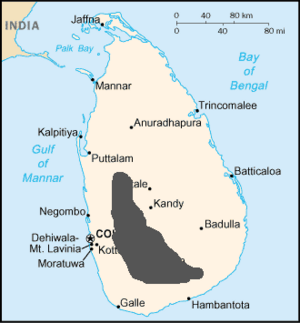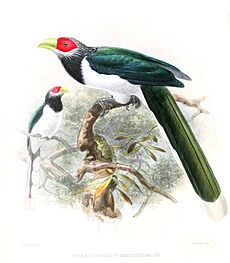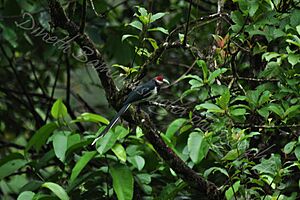Red-faced malkoha facts for kids
Quick facts for kids Red-faced malkoha |
|
|---|---|
 |
|
| Conservation status | |
| Scientific classification | |
| Genus: |
Phaenicophaeus
|
| Species: |
pyrrhocephalus
|
 |
|
The Red-faced Malkoha (Phaenicophaeus pyrrhocephalus) is a special kind of cuckoo bird. It belongs to the cuckoo family, but it's a bit different from most cuckoos. This amazing bird lives only in Sri Lanka, an island country.
Contents
What Does It Look Like?
The Red-faced Malkoha is a large bird, about 46 centimeters (18 inches) long. It has a very long tail that gets wider at the end. Its back is a dark green color. The top of its tail is green with white edges. Its belly and the underside of its tail are white, with black stripes on the tail.
The top of its head and its throat are black. The lower part of its face is white. But the most striking feature is a large, bright red patch around its eye! Its beak is green. You can tell males and females apart by their eyes: males have dark brown eyes, while females have creamy white eyes. Young birds are not as colorful.
What Does It Eat?
This bird eats many kinds of insects. It enjoys caterpillars, giant stick insects, and mantises. It also hunts small animals like lizards. Sometimes, it might eat berries, but scientists are still checking this.
What Does It Sound Like?
Unlike many cuckoos, the Red-faced Malkoha is a very quiet bird. It usually only makes soft grunting sounds.
Where Does It Live?
The Red-faced Malkoha is found only in Sri Lanka. It lives mostly in the Sinharaja Forest Reserve. This forest is a very important place for many different plants and animals. It is known as a "biodiversity hotspot" because it has so many unique living things.
What Kind of Home Does It Like?
This bird prefers to live in thick, dense forests. Even though it's big and colorful, it can be hard to spot among the trees. It likes forests in wet, low-lying areas. It also lives in forests on mountains and near rivers. You can see it in many of Sri Lanka's largest rainforests. It can also be found in some dry zone national parks like Yala National Park, Lahugala National Park, Wasgamuwa National Park, and Udawalawe National Park.
Reproduction
The Red-faced Malkoha builds a deep, cup-shaped nest. It hides the nest well among the leaves, usually about 5 to 12 meters (16 to 39 feet) high. A female typically lays 2 or 3 eggs. Both the male and female birds work together to build the nest.
Behaviour
These birds are often seen with other bird species. They join "mixed-species foraging flocks" in the Sinharaja area. This means different kinds of birds travel and look for food together. Red-faced Malkohas often stay at the front of these groups. So, if you watch the front part of a bird flock, you might have a better chance of seeing this special bird!
In Culture
The name malkoha comes from the Sinhala language, which is spoken in Sri Lanka. "Mal-Koha" means "flower-cuckoo." This bird is so important in Sri Lanka that it has even appeared on a 5 rupee Sri Lankan postal stamp!




